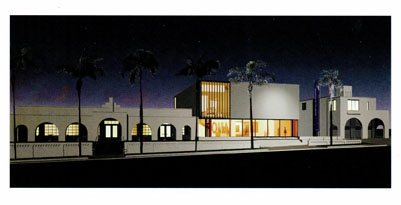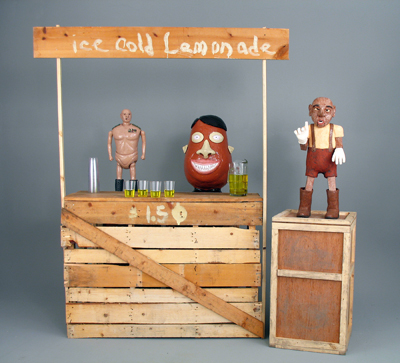 Oceanside Museum of Art …. Photo: OMA
Oceanside Museum of Art …. Photo: OMA
_____________________________________________________
 By Donald H. Harrison
By Donald H. Harrison
OCEANSIDE, California—The Jewish poetess Emma Lazarus is best known for the “New Colossus,” a poem that is engraved onto the base of the Statue of Liberty. She expressed the promise that America held for immigrants in 1876, the American centennial year that the statue was dedicated, with these best remembered lines of that poem:
“Give me your tired, your poor,
Your huddled masses yearning to breathe free,
The wretched refuse of your teeming shore.
Send these, the homeless, tempest-tossed to me,
I lift my lamp beside the golden door!”Such was the romance of Lady Liberty that no matter what time or in what weather their ships pulled into New York Harbor, immigrants crowded to the railing just to get a glimpse of her. The 19th century was a time when America opened its arms wide to those seeking new lives in the “New World,” and provided them with opportunities seemingly limited only by imagination. For Jews, immigrating to the “Goldeneh Medinah” meant the possibility of escaping grinding poverty and unbearably vicious European anti-Semitism into a land where one’s potential for success and status was fueled by one’s imagination and willingness to work.
Whereas Jews subsequently romanticized their family’s upward American mobility from an initial tenement on the Lower East to a nicer apartment in another part of New York City or to a home in the suburbs, people of other ethnicities had darker memories of more bitter experiences with immigration to America – provided they even were allowed to enter the country in the first place.
Imagine, as one UCSD student of Hispanic background did, Lady Liberty being magically transported from the East Coast of the United States far to the southwest and settling in Colonia Libertad in Tijuana, Mexico, where her base has been transformed into a pre-Columbian temple. In the vision of student Omar Pimienta, Lady Libertad (as she is now known) stands in stark juxtaposition to the network of high fences and patrolling U.S Border Patrol agents who now block Mexico’s “huddled masses” from gaining entry into the United States.
Rather than with a sense of nostalgia, Pimienta looks upon America’s attitude toward immigrants with undisguised disappointment over the gap between Lady Liberty’s memorable words and the actuality of America’s closed-door immigration policy for the peoples of poor, needy nations such as Mexico.
Pimienta’s installation includes a model of Lady Libertad along with a video narrating the story of the construction of the original Statue of Liberty while showing scenes of a base being constructed in Tijuana for an inflatable Lady Libertad.
Juxtaposition is an essential ingredient of the experiences offered by the Oceanside Museum of Art, an institution that wends its way through side-by-side buildings of contrasting architectural styles. The colonnade on the left of the main entrance is the prominent feature of a Mission-style building by San Diego architect Irving Gill. To the right is the central pavilion by Frederick Fisher, a Santa Monica architect known for deceptively simple post-modernist designs. To the right of this is another arched structure, creating symmetry with Gill’s.
The Oceanside Museum of Art is itself a study in contrast with the image of the host city of Oceanside, which because of its proximity to the sprawling Camp Pendleton Marine Corps Base is viewed as a politically conservative town. Yet, as the work of Pimienta demonstrates, messages propounded by the museum’s featured artists can be politically provocative.
The same clearly may be said about “An American Dream,” a series of installations by ceramicist Gregg Jabs expressing disillusionment with some of America’s cherished myths.
A statement by curator Teri Sowell, PhD. recites the fact that James Truslow Adams coined the term ”the American Dream” in 1931 to describe ‘that dream of land in which life should be better, richer and fuller for everyone, with opportunity for each according to ability and achievement. It is difficult for European upper classes to interpret this adequately and too many of us ourselves have grown weary and distrustful of it.
“It is not a dream of motor cars and high wages merely, but a dream of social order and what each man and each woman shall be able to obtain to the fullest stature of which they are innately capable and be recognized by others for what they are…..” However, “unemployment, foreclosures, and loss of retirement security currently undermine the core American ideal that hard work pays off ; for many the dream of a secure, paying job; home ownership have diminished into a nightmare of debt and hopelessness.”
 Each installation may resonate with different visitors, but from the standpoint of juxtaposition, one featuring a lemonade stand conveys the message.
Each installation may resonate with different visitors, but from the standpoint of juxtaposition, one featuring a lemonade stand conveys the message.
Instead of innocent children selling lemonade on a warm summer day, the people staffing this stand are a cynical politician, who is represented by a Pinocchio-like clay figure, and a sinister looking lieutenant general. After taking a drink, a Humpty Dumpty like figure ponders whether he has been led to a great fall.
One can imagine how the military brass at neighboring Camp Pendleton might take exception to the characterization of a lieutenant general not as a protector of our freedoms, but as one who might be destroying them. This particular installation, provocatively enough, is named “Patriotic Duty.”
Jabs takes another jab at America’s fortunes with an installation showing a boy peering out the back seat window of the family automobile at the countryside. He sees a man and a woman each holding pitchforks—a quotation, if you will, of Grant Wood’s famous “American Gothic.” But these two figures who are out standing in their field are faceless, and their farm is not what it seems. Those glitzy flamingoes in their front yard are actually vultures in disguise, and there is evidence all around them of the death and destruction upon which they feed.
Jabs’ works have been on display since August 30. They will remain at the museum only through January 10. Pimienta and seven fellow UCSD students have been featured since Nov. 20 in an exhibit entitled San Diego NOW. That exhibit closes Jan. 3. If you’re looking for something to do between now and New Year’s Day, see both exhibits while they still are together.
*
Harrison is editor of San Diego Jewish World